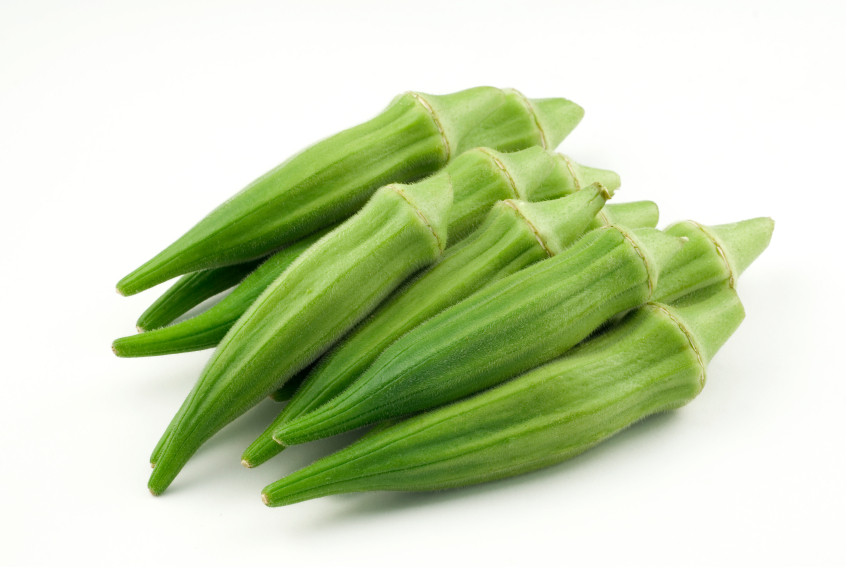It is easy to be turned off by the mucilaginous or slimy properties of Okra but the next time you go for groceries you might buy more than a few. Okra contains many essential vitamins and minerals and is easily one of health’s fortunes. This vegetable is ‘packed’ with nutrients.
Okra is known by many names across the world such as gumbo and lady finger – so called because of its tapering shape. It ranges between 3-10 inches in length and its pod contains many small white seeds. This unusual plant originated in Ethiopia and was brought across this side of the world during the slave trade. Despite its warm origins Okra flourishes very well in the more temperate climate of America’s South.
Nutritional benefits
The benefits of Okra are many; according to research it can help the body to fight illnesses such as osteoporosis, heart disease, arthritis and hypertension, among others. Okra fights these illnesses because of its many dietary fibres, protein, vitamins and minerals – including vitamins A, B1, B2, B6 and C, potassium, magnesium, sodium, iron, folate, calcium and thiamine. It is low in calories and contains absolutely no fat.
What does all this mean?
Blood sugar is affected by the rate at which it is absorbed by the intestines, the fibres in okra curb this rate and as such help to stabilise blood sugar.
It helps to fight hypertension since it is an abundant source of potassium which reduces the blood pressure. Potassium also transmits nerve impulses and regulates the body’s water balance – this helps the kidneys to function. Potassium is also important for the digestive, heart and muscular functions.
According to information found on the University of Maryland Medical’s website, it is used to treat asthma, inflammatory bowel disease and hypokalemia. It also purports that persons who consumes adequate amounts are less likely to develop stroke, osteoporosis and high blood pressure.
The fibres found in okra also help to prevent or reduce constipation. Its mucilage or slippery characteristic aids in the comfortable elimination of the body’s waste and importantly, it does not irritate the intestinal tract as is noticed with other sources of fibre such as wheat bran. This insoluble fibre also helps to fight heart disease in both men and women and also aids the body to fight against diabetes and obesity. It has also been reported to cleanse the intestines. The results of much research have proved that most diseases that we suffer today start with problems in the small intestine; as such it is the active ingredient in ‘Okra Pepsin E3’ – developed for patients with stomach ulcers. This is achieved because okra feeds the intestinal tract with the ‘good’ bacteria, probiotics.
Okra’s calcium, folic acid, and magnesium are very important for women. Calcium and magnesium helps to fight osteoporosis. In America today one in every two women over the age of 50 suffers as a result of fractures related to osteoporosis. This is the case even though many get the required levels of calcium from dairy products – women in countries such as Japan, who get most of their calcium from non-dairy sources do not have these problems – this is food for thought!
According to the ‘Latest Diet News’, Canadian researchers have recently reported that vegetables such as okra lowers cholesterol almost as much as cholesterol-lowering statin drugs.
Okra is among the list of preferred food that is advocated in what is now called the ‘Portfolio Diet’ put together by a group of Canadian researchers directed by Cyril Kendall of the University of Toronto. The ‘Portfolio Diet’ emphasised a daily intake of soy and soluble fibre (including okra) which has the potential to lower cholesterol by an impressive one-third.
Okra is also a producer of glutathione. Researchers at Emory University in a study of 1800 people found that people who had a high intake of glutathione (a protein molecule made up of three amino acids) were 50% less likely to develop oral and throat cancers.
Preparation
There are many ways to prepare okra but according to nutritionist Sylvia W. Zook, PhD., okra should be cooked as little as possible so as to retain much of its self digesting enzymes and nutrients. With this in mind, okra can be braised, sautéed, grilled, steamed, fried, and pickled. It can also be eaten raw. Usually it is used to complement many dishes since it goes well with meats, seafood, salads and soups. The acetylated acidic polysaccharide and galaturonic acid, which is responsible for okras mucilaginous also makes it an excellent thickening agent.
Derivatives
Derivatives from okra include Okra oil; its dried seed is also grounded and used as a substitute for coffee.
Summary
Okra is undoubtedly an excellent and natural source of many nutrients; there are no known side-effects, as is the case with many prescription medications we take today to provide our bodies with needed supplements. It is one of the cheapest vegetables on the market albeit less known.
This article is copyrighted by Ital is Vital, 2024. Want to re-post this article? Visit our guidelines.
DISCLAIMER: THIS WEBSITE DOES NOT PROVIDE MEDICAL ADVICE
The information, including but not limited to, text, graphics, images and other material contained on this website are for informational purposes only. The purpose of this website is to promote broad consumer understanding and knowledge of various health topics. It is not intended to be a substitute for professional medical advice, diagnosis or treatment. Always seek the advice of your physician or other qualified health care provider with any questions you may have regarding a medical condition or treatment and before undertaking a new health care regimen, and never disregard professional medical advice or delay in seeking it because of something you have read on this website.
